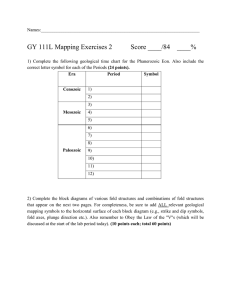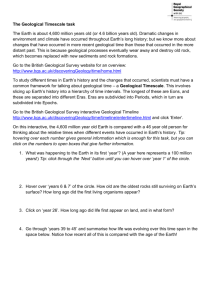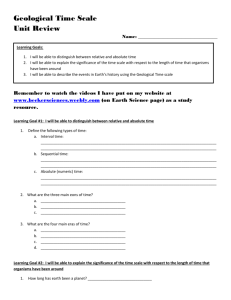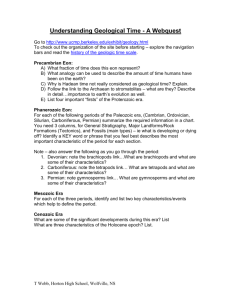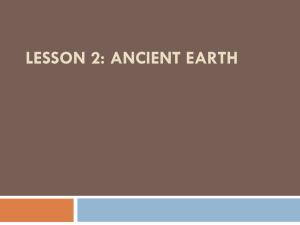GY 111: Physical Geology Lecture 18: Geological Time UNIVERSITY OF SOUTH ALABAMA
advertisement
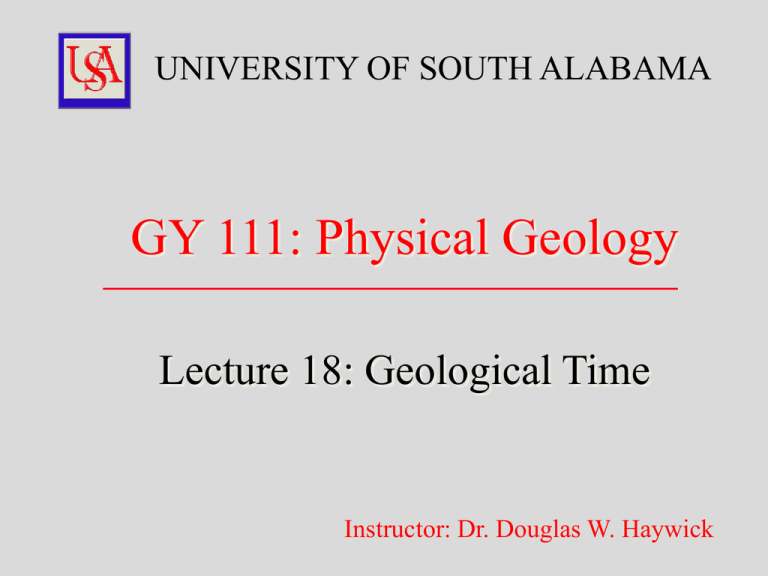
UNIVERSITY OF SOUTH ALABAMA GY 111: Physical Geology Lecture 18: Geological Time Instructor: Dr. Douglas W. Haywick Last Time 1) Deep Marine Environments 2) Groundwater Web notes 17 Deep Marine Environments The deepest part of the ocean floor is relatively flat and is called the abyssal plain. http://faculty.gg.uwyo.edu/heller/Sed%20Strat%20Class/SedStrat%207/SedStrat7.html Submarine Fans Submarine fans: accumulations of siliciclastic sediment from the shelf break onto the base of the continental slope http://www.dkimages.com/discover/previews/851/20117924.JPG Submarine Fans Submarine fans can also be divided into 3 zones 1 2 3 http://www.geol.umd.edu/~jmerck/geol100/lectures/31.html 1: Proximal (upper) 2: Middle 3: Distal (lower) Deep Marine Transport Mechanisms Density currents have long been studied by geologists and engineers. Ultimately they produce one of the most diagnostic rock types in geology… The turbidite. http://serc.carleton.edu/ http://instruct.uwo.ca/earth-sci/200a-001/07turbidity.jpg Turbidites Turbidites are formed due to sedimentation from a gradually slowing density current and are primarily recognized on the basis of their fining-upward nature. http://regentsprep.org/Regents/earthsci/units/weathering/gradedbedding.gif Chalk Siliciclastic sediment is not the only deep water deposit on the seafloor. You also get chalk (it tends to form on the abyssal plane in areas free of siliciclastic input) The “white cliffs” of Dover, England http://farm1.static.flickr.com/119/290719612_5a27cbaf61.jpg Chalks You can only see these “beasties” (coccoliths) under an electron microscope. There are estimated to be 40 billion of them in every sugar cube-sized piece of chalk on the planet (that’s a lot!). http://www.physicalgeography.net/fundamentals/images/chalk.jpg 0.001mm Hydrosphere The hydrosphere is defined as all the water above, on and in the Earth hydrosphere Hydrological Cycle Water in the hydrosphere is circulated within the hydrological cycle http://www.coloradocollege.edu/dept/ev/courses/EV211WWW/hydrological%20cycle.jpg Groundwater Groundwater is water that infiltrates below the Earth’s surface Porosity: percent void space in a material Permeability: degree of connectivity of pores (ability of a material to transmit a fluid) Common permeable geological material includes the sandstones, limestone, marble, fault breccia http://www.belmont.sd62.bc.ca/teacher/geology12/photos/erosion-water/permeability.gif Water Table Undersaturated zone (Vadose) Straight down water movement Saturated zone (Phreatic) Lateral? water movement http://myweb.cwpost.liu.edu/vdivener/notes/water_table.gif The water table is a planar surface that separates the saturated and undersaturated zones Water Table Porous layers that are capable of passing water and releasing it at springs and/or wells are called aquifers. http://www.tol.ca/files/web_images/engineering/environment/WebImages/unconfined.jpg Water Table Clay layers may act as aquicludes and generate a perched water table (a localized water table). Terminology Potentiometric Surface: elevation to which the pressurized water in a confined aquifer will rise Artesian Well: water rises to an elevation above the aquifer Flowing Artesian Well/Spring: potentiometric surface is above the ground surface http://www.douglas.co.us/water/images/Denver_Basin_Aquifers_clip_image004.jpg Groundwater Issues • Contamination of groundwater supply Karst Topography Limestone dissolution features are abundant and diverse both at the surface and underground Karst Topography Like meandering rivers, the degree of karstification can be related to “age” Assignment 3 Water table contours Ground water flows according to elevation differences of the water table.... which is a surface, It can be contoured Assignment 3 Water table contours Flow direction is down gradient Assignment 3 Water table contours Flow direction is down gradient Assignment 3 Water table contours Flow direction is down gradient Today’s Agenda A) How long is long? B) Geological time divisions Web notes 18 Geological Time The problem is that we have to deal with a lot of time. Geological Time The problem is that we have to deal with a lot of time. 4.6 GA = 4,600,000,000 years Geological Time Time 0 MA (today) 4.6 GA Geological Time Time Eon 0 MA (today) Eons: the largest division of geological time 4.6 GA Geological Time Time Eon Time 0 MA (today) 4.6 GA Hadean 4.6 Ga to 4.2* Ga * the upper age boundary varies as the oldest rocks on the planet change. The shift from 4.1 to 4.2 GA occurred in October 2008 following the discovery of really old rocks in northern Canada. Geological Time Time Eon Time 0 MA (today) 4.6 GA Archean 4.2 Ga to 2.5 Ga Hadean 4.6 Ga to 4.2 Ga Geological Time Time Eon Time 0 MA (today) Proterozoic 2.5 GA to 550 Ma 4.6 GA Archean 4.2 Ga to 2.5 Ga Hadean 4.6 Ga to 4.2 Ga Geological Time Time Eon 0 MA (today) Phanerozoic 550 MA to 0 MA Proterozoic 2.5 GA to 550 Ma Archean 4.2 Ga to 2.5 Ga Hadean 4.6 Ga to 4.2 Ga 4.6 GA Time Geological Time Time Eon 0 MA (today) Phanerozoic Era Time Proterozoic Archean Hadean 4.6 GA Eras: the 3-fold division of the eons Geological Time Time Eon 0 MA (today) Phanerozoic Era Time Proterozoic Archean 4.6 GA Hadean Early, Middle, Late 4.2 Ga to 2.5 Ga 4.6 Ga to 4.2 Ga Geological Time Time Eon 0 MA (today) Phanerozoic Proterozoic Era Time Neoproterozoic 900 MA to 550 Ma Mesoproterozoic 1.6 GA to 900 MA Paleoproterozoic 2.5 GA to 1.6 GA Archean 4.2 Ga to 2.5 Ga Hadean 4.6 Ga to 4.2 Ga 4.6 GA Geological Time Time Eon 0 MA (today) Phanerozoic Proterozoic Era Time Cenozoic 65 MA to 0 MA Mesozoic 245 MA to 65 MA Paleozoic 550 MA to 245 MA Neoproterozoic 900 MA to 550 Ma Mesoproterozoic 1.6 GA to 900 MA Paleoproterozoic 2.5 GA to 1.6 GA Archean 4.2 Ga to 2.5 Ga Hadean 4.6 Ga to 4.2 Ga 4.6 GA Geological Time Time Eon 0 MA (today) Phanerozoic Proterozoic Era Time Cenozoic 65 MA to 0 MA Mesozoic 245 MA to 65 MA Paleozoic 550 MA to 245 MA Neoproterozoic 900 MA to 550 Ma Mesoproterozoic 1.6 GA to 900 MA Paleoproterozoic 2.5 GA to 1.6 GA Archean 4.2 Ga to 2.5 Ga Hadean 4.6 Ga to 4.2 Ga 4.6 GA Geological Time Era Period Cenozoic (0 to 65 Ma) Quaternary (0 to 2 Ma) Tertiary (2 MA to 65 Ma) Periods: the most useful subdivisions of (mostly) the Phanerozoic eon Mesozoic (65 to 251 Ma) Cretaceous (65 to 144 Ma) Jurassic (144 to 208 Ma) Triassic (208 to 251 Ma) Paleozoic (251 to 542 Ma) Permian (251 to 286 Ma) Pennsylvanian (286 to 320 Ma) Mississippian (320 to 362 Ma) Devonian (362 to 418 Ma) Silurian(418 to 441 Ma) Ordovician (441 to 505 Ma) Cambrian (505 to 542 Ma) Proterozoic (2500 Ma to 542 Ma) Geological Time Era Period Cenozoic (0 to 65 Ma) Quaternary (0 to 2 Ma) Tertiary (2 MA to 65 Ma) Periods: the most useful subdivisions of (mostly) the Phanerozoic eon Mesozoic (65 to 251 Ma) Cretaceous (65 to 144 Ma) Jurassic (144 to 208 Ma) Triassic (208 to 251 Ma) Paleozoic (251 to 542 Ma) Permian (251 to 286 Ma) Pennsylvanian (286 to 320 Ma) Mississippian (320 to 362 Ma) Devonian (362 to 418 Ma) Silurian(418 to 441 Ma) Ordovician (441 to 505 Ma) Cambrian (505 to 542 Ma) Proterozoic (2500 Ma to 542 Ma) Ediacarin* (600 to 542 Ma) Cryogenian* (850 to 600 Ma) Geological Time Era Period Epoch Cenozoic (0 to 65 Ma) Quaternary (0 to 2 Ma) Holocene (0 to 10 Ka) Tertiary (2 MA to 65 Ma) Pleistocene (10 Ka to 2 Ma) Pliocene (2 Ma to 5 Ma) Miocene (5 Ma to 24 Ma) Oligocene (24 to 37 Ma) Eocene (37 Ma to 58 Ma) Paleocene (58 to 65 Ma) Periods: the most useful subdivisions of (mostly) the Phanerozoic eon Mesozoic (65 to 251 Ma) Cretaceous (65 to 144 Ma) Jurassic (144 to 208 Ma) Triassic (208 to 251 Ma) Paleozoic (251 to 542 Ma) Permian (251 to 286 Ma) Pennsylvanian (286 to 320 Ma) Mississippian (320 to 362 Ma) Devonian (362 to 418 Ma) Silurian(418 to 441 Ma) Ordovician (441 to 505 Ma) Cambrian (505 to 542 Ma) Proterozoic (2500 Ma to 542 Ma) Ediacarin* (600 to 542 Ma) Cryogenian* (850 to 600 Ma) Lots of Epochs in All Periods Today’s Homework 1. Organize your notes (Lecture test 2 coming up soon) 2. Groundwater Assignment due next Thursday 3. Compose a symphony in 3-part harmony Next Time Bedding, Attitude and Geological maps GY 111: Physical Geology Lecture 18: Geological Time Instructor: Dr. Doug Haywick dhaywick@southalabama.edu This is a free open access lecture, but not for commercial purposes. For personal use only.
